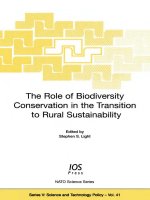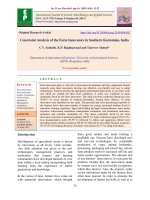Role of farm women in paddy cultivation practices in Thanjavur district, India
Bạn đang xem bản rút gọn của tài liệu. Xem và tải ngay bản đầy đủ của tài liệu tại đây (197.38 KB, 4 trang )
Int.J.Curr.Microbiol.App.Sci (2018) 7(12): 47-50
International Journal of Current Microbiology and Applied Sciences
ISSN: 2319-7706 Volume 7 Number 12 (2018)
Journal homepage:
Review Article
/>
Role of Farm Women in Paddy Cultivation Practices
in Thanjavur District, India
S. Santhi*, V. Kalirajan and K. Kanaga Sabapathi
Department of Agricultural Extension, Faculty of Agriculture, Annamalai University,
Annamalai Nagar, India
*Corresponding author
ABSTRACT
Keywords
Farm women, Role of
paddy cultivation
practices
Article Info
Accepted:
04 November 2018
Available Online:
10 December 2018
Women are involved both in production as well as in processing of paddy crops. The role
of farm women in paddy cultivation practices is remarkable. Female labourers contributed
significantly to the economic well-being of their families, hence, the level of income and
welfare of a household will depend on the degree of their effective participation. Hence,
the study is on ‘role of farm women in paddy cultivation practices’. The study was
conducted in Orathanadu and Thiruvonam blocks of Orathanadu taluk in Thanjavur district
with a sample of 120 farm women selected based on proportionate random sampling
procedure. With regard to their role of farm women in paddy cultivation practices, high
level of involvement was observed in were ‘weed management’, ‘nursery management’,
‘time of sowing’, ‘harvesting’, ‘selection of season’ and ‘irrigation management’. Low
level of involvement was observed in ‘post-harvest operation’, ‘seed treatment’, ‘fertilizer
management for main field’, ‘main field preparation’, ‘disease management’, ‘pest
management’, ‘selection variety’ and ‘marketing’.
women cultivators are typically and wrongly
characterized as economically inactive and
women cultivators play only a supportive role
in agriculture as farmers’ wives (Samanta
1995). Women must be given full chance to
participate in decision making as they are
actively engaged in home and farm activities.
Women’s active involvement in decision
making is considered essential for rapid
economic development of the country.
Introduction
Indian rural women always play an important
role and remain as a prominent partner of
agricultural sector. Women form one – third of
the world’s official labour force but are
concentrated in the lowest paid occupation and
are more vulnerable to unemployment than
men. Rural Indian Women are extensively
involved in agricultural activities, however,
the nature and extent of their involvement
differs with the variations in agro-production
systems. Raghuvanshi (1982) reported that
women are employed in any remunerative
work for 247 days in a year and they are in
need of gainful employment. Over the years,
Singh et al., (2005) reported a higher
participation of farm women in agricultural
activities. Fabiyi et al., (2007) reported that
farm women were involved in land clearing
activities (58.00 per cent), in planting (72.00
47
Int.J.Curr.Microbiol.App.Sci (2018) 7(12): 47-50
per cent), in weeding (80.00per cent), in
transporting products (82per cent), in
harvesting (93.00per cent), and in marketing
(88.00 per cent).
cleaning and seed selection, 29.16 per cent in
sowing, where found involved in this farm
activities. Only and 18.33 and 10.00 per cent
were found involved in improved variety and
seed treatment activities respectively.
Mishra et al., (2009) revealed that rural
women participated in larger number in the
practices like nursery management (63.50 per
cent), seeds storage (52.50 per cent),
transplantation (41.50 per cent), weeding
(40.50 per cent).
The results obtained from the above study as
well as discussion have been summarized
under following headings
Role of farm women in paddy cultivation
practices
Neelam Jaiswal (2016) revealed that majority
of the respondents were involved 91.66 per
cent in transplanting, 85.00 per cent in
weeding, 76.66 per cent in harvesting, 70.83
per cent in storage and 66.66 per cent of them
in threshing activities of farm. While the
activities found after threshing, 62.50 per cent
respondents in winnowing, 35.00 per cent in
Farm women play a significant and crucial
role in agricultural development and allied
fields. In the study area women participate
numerous activities expect felling of trees and
spraying of chemicals. In paddy cultivation
totally fourteen agricultural practices were
identified for the study.
Table.1 Distribution of farm women according to their role of paddy cultivation practices
n=120
Sl. No.
Operations
Frequency
Per cent
Season
56
1.
46.66
2.
3.
4.
5.
6.
7.
8.
Selection of variety
Seed treatment
Time of sowing
Nursery management
Main field preparation
Irrigation management
Fertilizer management for main field
24
40
69
75
45
55
33
20.00
33.33
57.50
62.50
37.50
45.83
27.50
9.
10.
11.
Weed management
Pest management
Disease management
120
25
26
100.00
20.83
21.66
12.
Harvesting
65
54.16
13.
Post-harvest operation
50
41.66
14.
Marketing
15
12.50
48
Int.J.Curr.Microbiol.App.Sci (2018) 7(12): 47-50
management for main field’ (27.50 per cent),
‘disease management’ (21.66 per cent), ‘pest
management’ (20.83 per cent) and ‘selection
of variety (20.00 per cent). A smaller
proportion (12.05 per cent) participated in
marketing.
Role of farm women in paddy cultivation
operations were analysed and the results are
presented in Table 1and Figure 1.
It could be observed from the Table 1, 100.00
per cent of the farm women were participated
in weed management. More than 50.00 per
cent of the farm women play an important
role in ‘nursery management’ (62.50 per
cent), ‘time of sowing’ (57.50 per cent) and
‘harvesting, (54.16 per cent). The role in
operations
like
‘season’,
‘irrigation
management’, ‘post-harvest-operation’ and
‘seed treatment’ whereas found to be the
major roll of farm women expressed by 46.66,
45.83, 41.66 and 33.33 per cent of the
respondents respectively. Nearly one-fourth
of the respondents played a role in the paddy
cultivation
practices
like
‘fertilizer
References
Fabiyi, E.F., Danladi, B.B., Akande and Y.
Mahmood. 2007. Role of Women in
Agricultural Development and their
Constraints: A Case Study of Biliri
Local Government Area, Gombe State,
Nigeria. Pakistan Journal of Nutrition, 6
(6): 676 – 680.
Mishra, A., A. Mishra and A.K. Dubey. 2009.
Participation of Rural Women in
49
Int.J.Curr.Microbiol.App.Sci (2018) 7(12): 47-50
Decision Making, Indian Res. J. Ext.
Edu., 9(3): 23-27.
Neelam Jaiswal 2016. Assessment of Training
Needs of Farm Women With Reference
to Rice Production Technology in
Korba District of Chhattisgarh, M.Sc.,
(Ag.)
Thesis,
Department
of
Agricultural Extension, College of
Agriculture, Faculty of Agriculture,
Indira Gandhi Krishi Vishwavidyalaya
Raipur (C.G.).
Raghuvanshi,
K.
1982.
Appropriate
Technology to Help Rural Women,
Kurukshetra, 43(11): 103-104.
Samanta, R. K. 1995. Improving Women
Farmers, Access of Extension Services,
in Women in Agriculture, Perspective,
Issues and Experiences, (ed.) R.K.
Samanta. M.D. Publications Pvt. Ltd.,
Singh, S.P., L.P. Gite, Nirmal Kumar and
Nidhi Agarwal. 2005. Involvement of
Farm Women of Vindhyan Plateau,
Agri. Extn. Rev., 1: 20-26.
How to cite this article:
Santhi, S., V. Kalirajan and Kanaga Sabapathi, K. 2018. Role of Farm Women in Paddy
Cultivation Practices in Thanjavur District. Int.J.Curr.Microbiol.App.Sci. 7(12): 47-50.
doi: />
50









